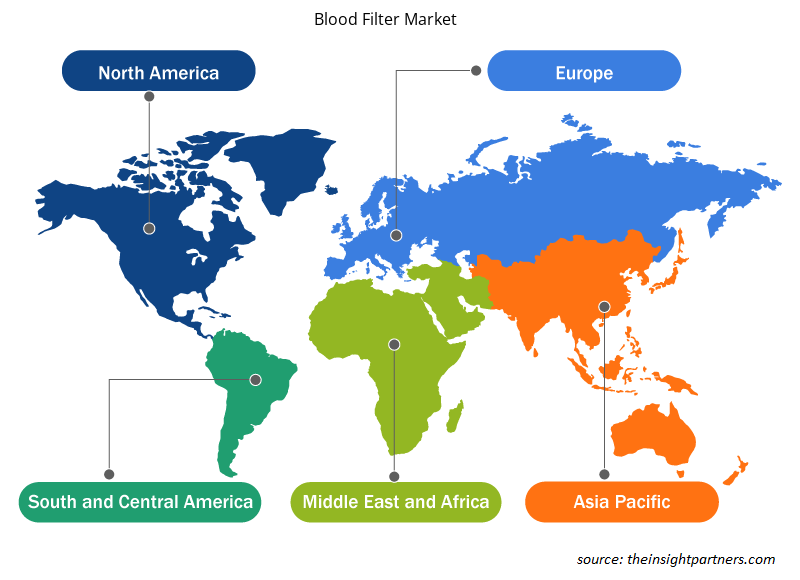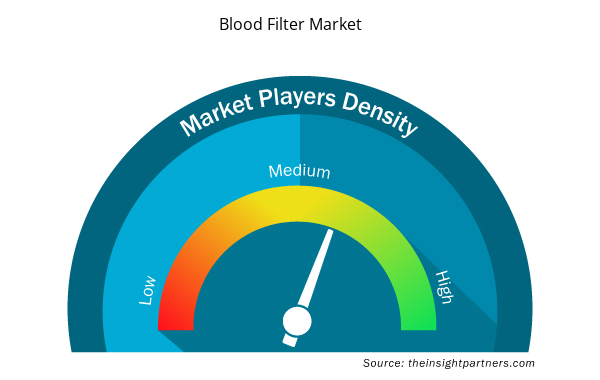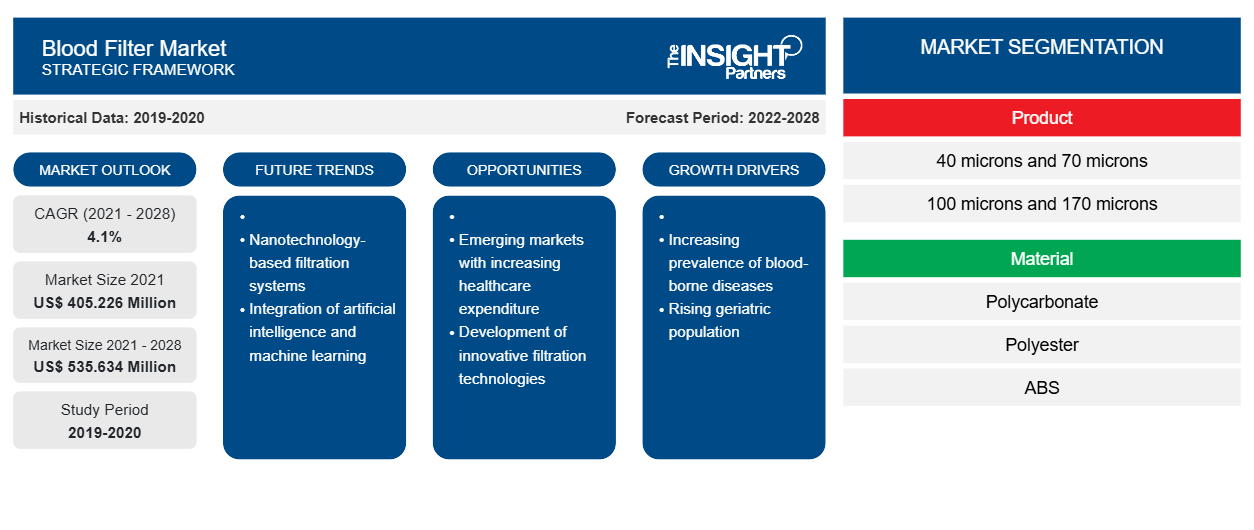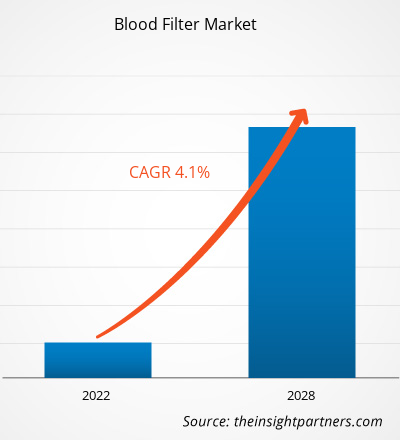血液过滤器市场规模预计将从 2021 年的 4.05226 亿美元增至 2028 年的 5.35634 亿美元;预计 2021 年至 2028 年的复合年增长率为 4.1%。
血液过滤器是一种由聚酯或尼龙编织网组成的筛网式过滤器,放置在产品袋和患者之间进行过滤。这些过滤器旨在保护患者免受大聚集体和非血液成分颗粒物的侵害,这些物质如果进入血液可能会有害。它们在输血过程中去除大聚集体,如微聚集体位点和纤维蛋白聚集体。过滤包括捕获在血液储存过程中形成的由白细胞、纤维蛋白和血小板制成的颗粒和大聚集体。慢性病负担增加、创伤和事故病例激增以及输血程序数量增加等因素推动了血液过滤器市场的增长。然而,产品召回阻碍了市场的增长。
定制此报告以满足您的需求
您可以免费定制任何报告,包括本报告的部分内容、国家级分析、Excel 数据包,以及为初创企业和大学提供优惠和折扣
- 获取此报告的关键市场趋势。这个免费样品将包括数据分析,从市场趋势到估计和预测。
市场洞察
输血程序数量的增加促进了血液过滤器市场的增长
提高输血程序所需的安全、充足血液的供应量应成为每个国家国家医疗保健政策和基础设施不可或缺的一部分。城市和农村地区随时都有输血需求。过去,血液供应不足导致许多患者因疾病而死亡。通过为定期、自愿和无偿献血者提供稳定的设施,可以确保安全血液的充足和可靠供应。他们也是最安全的献血者群体,因为这些献血者中血源性感染的患病率最低。
最常见的需要输血的手术包括心血管手术、剖腹产手术和受伤。根据美国国家心肺血液研究所和美国国立卫生研究院 (NIH) 的估计,每年有超过 500 万人需要输血。此外,由于自然灾害和广泛的伤亡,全世界对输血的需求正在增加。贫血、红细胞增多、白细胞增多、白细胞减少和血小板增多等血液疾病发病率的激增也推动了血液过滤器市场的增长。根据世界卫生组织的数据,大多数患有地中海贫血的儿童出生在低收入国家,这些国家很难获得输血,或者只有一小部分人口可以获得输血。
输血程序中使用的血液过滤器是由聚酯或尼龙制成的编织网;这些是放置在产品袋和患者之间的筛网式过滤器。这些过滤器旨在保护患者免受潜在有害大聚集物(如血小板、白细胞和纤维蛋白)和非血液成分颗粒物的伤害。在大多数发达国家,输血过滤器由政府或社区计划提供。因此,适当的献血设施和自愿献血者的可用性推动了输血程序的数量,从而促进了血液填充剂市场的增长。
基于产品的见解
根据产品,血液过滤器市场进一步细分为 40 微米和 70 微米、100 微米和 170 微米等。100 微米和 170 微米细分市场将在 2021 年占据最大市场份额,预计在预测期内将实现更高的复合年增长率。
基于材料的洞察
根据材料,血液过滤器市场分为聚碳酸酯、聚酯、ABS 等。聚酯部分将在 2021 年占据最大的市场份额,达到 35.47%,预计在预测期内将保持主导地位。
基于应用的洞察
根据应用,血液过滤器市场细分为血液处理和输血。输血部分将在 2021 年占据最大的市场份额,达到 73.83%,预计在预测期内仍将保持主导地位。
基于最终用户的洞察
根据最终用户,血液过滤器市场分为血库、医院和其他。血库部分将在 2021 年占据最大的市场份额,达到 47.38%,预计在预测期内仍将保持主导地位。
在血液过滤器市场运营的各家公司正在采用产品发布、并购、合作、产品创新和产品组合扩展等策略,以扩大其全球影响力、维护品牌名称并满足最终用户日益增长的需求。
血液过滤器市场区域洞察
Insight Partners 的分析师已详尽解释了预测期内影响血液过滤器市场的区域趋势和因素。本节还讨论了北美、欧洲、亚太地区、中东和非洲以及南美和中美洲的血液过滤器市场细分和地理位置。

- 获取血液过滤器市场的区域特定数据
血液过滤器市场报告范围
| 报告属性 | 细节 |
|---|---|
| 2021 年市场规模 | 4.05226亿美元 |
| 2028 年市场规模 | 5.3563.4 亿美元 |
| 全球复合年增长率(2021 - 2028) | 4.1% |
| 史料 | 2019-2020 |
| 预测期 | 2022-2028 |
| 涵盖的领域 | 按产品
|
| 覆盖地区和国家 | 北美
|
| 市场领导者和主要公司简介 |
|
血液过滤器市场参与者密度:了解其对业务动态的影响
血液过滤器市场正在快速增长,这得益于终端用户需求的不断增长,而这些需求又源于消费者偏好的不断变化、技术进步以及对产品优势的认识不断提高等因素。随着需求的增加,企业正在扩大其产品范围,进行创新以满足消费者的需求,并利用新兴趋势,从而进一步推动市场增长。
市场参与者密度是指在特定市场或行业内运营的企业或公司的分布情况。它表明在给定市场空间中,相对于其规模或总市场价值,有多少竞争对手(市场参与者)存在。
在血液过滤器市场运营的主要公司有:
- 旭化成公司
- 费森尤斯卡比公司
- 宏科药业
- 血液透析公司
- 信息咨询公司
免责声明:上面列出的公司没有按照任何特定顺序排列。

- 了解血液过滤器市场顶级关键参与者概况
血液过滤器市场 – 按产品分类
- 40 微米和 70 微米
- 100 微米和 170 微米
- 其他的
血液过滤器市场 – 按材料分类
- 聚碳酸酯
- 聚酯纤维
- 防抱死制动系统
- 其他的
血液过滤器市场 – 按应用
- 血液处理
- 输血
血液过滤器市场 – 按最终用户划分
- 血库
- 医院
- 其他的
血液过滤器市场 – 按地区划分
- 北美
- 我们
- 加拿大
- 墨西哥
- 欧洲
- 法国
- 德国
- 意大利
- 英国
- 西班牙
- 欧洲其他地区
- 亚太地区 (APAC)
- 中国
- 印度
- 韩国
- 日本
- 澳大利亚
- 亚太其他地区
- 中东和非洲 (MEA)
- 南非
- 沙特阿拉伯
- 阿联酋
- 中东和非洲其他地区
- 南美和中美洲(SCAM)
- 巴西
- 阿根廷
- 南美洲和中美洲其他地区
公司简介
- 旭化成公司
- 费森尤斯卡比公司
- 宏科药业
- 血液透析公司
- 信息咨询公司
- 钟化株式会社
- 川澄研究所
- 赛发公司
- 山东中宝康医疗器械有限公司
- 南京双维生物科技有限公司
- 历史分析(2 年)、基准年、预测(7 年)及复合年增长率
- PEST 和 SWOT 分析
- 市场规模价值/数量 - 全球、区域、国家
- 行业和竞争格局
- Excel 数据集



Report Coverage
Revenue forecast, Company Analysis, Industry landscape, Growth factors, and Trends

Segment Covered
This text is related
to segments covered.

Regional Scope
North America, Europe, Asia Pacific, Middle East & Africa, South & Central America

Country Scope
This text is related
to country scope.
常见问题
Global blood filter market is segmented by region into North America, Europe, Asia Pacific, Middle East & Africa, and South & Central America. In North America, The US holds the largest size of the market in this region. Nearly 16 million blood components are transfused each year in the U.S. According to the American Cancer Society, more than 1.8 million people are expected to be diagnosed with cancer in 2020. Many of them will need blood, sometimes daily, during their chemotherapy treatment. Blood products are transfused through intravenous tubing with filters. The filters, which typically have pore diameters of 170 to 260 microns, are used to prevent particulate debris from being administered as well. The trapped material promotes bacterial growth, and the American Association of Blood Banks (AABB) recommends not using a filter for more than 4 hours. The government is also experiencing increasing chronic conditions such as acute kidney injury (AKI), multiple organ dysfunction syndromes, or sepsis. Thus, it is expected that rising incidences of chronic diseases are likely to influence the market's growth. Moreover, the rise in transplant procedures across the United States is expected to increase the blood transfer procedures that require collection units such as tubes, bags, and others. According to the Red Cross Blood Center, 4.5 million Americans require blood transfusion annually.
The blood filter market majorly consists of players such Asahi Kasei Corporation, Fresenius Kabi AG, Macopharma, Haemonetics Corporation, Infomed SA, KANEKA CORPORATION, Kawasumi laboratories. Inc., Sefar AG, Shandong Zhongbaokang Medical Implements Co., Ltd, Nanjing Shuangwei Biotechnology Co., Ltd. among others.
The blood transfusion segment dominated the global blood filter market and accounted for the largest revenue share of 73.83% in 2021
The blood banks segment dominated the global colon blood filter market and accounted for the largest revenue share of 47.38% in 2021.
A blood filter is a screen-type filter composed of woven mesh made from polyester or nylon, and it is placed between the product bag and the patient for performing filtration. These filters are intended to protect patients from macro-aggregates and non-blood component particulate matter that could be hazardous if enter the bloodstream. They remove macro-aggregates such as micro-aggregate sites and fibrin aggregates during a blood transfusion. Filtration involves capturing particles and macro-aggregates made from leucocytes, fibrin, and platelets, formed during blood storage.
Key factors that are driving the growth of this market are an increase in the burden of chronic diseases, a surge in cases of trauma and accidents, and a rising number of blood transfusion procedures are expected to boost the market growth for the blood filter over the years.
The 100micron and 170-micron segment dominated the global blood filter market and held the largest revenue share of 56.80% in 2021.
The polyester segment dominated the global blood filter market and held the largest revenue share of 35.47% in 2021.
Trends and growth analysis reports related to Life Sciences : READ MORE..
The List of Companies - Blood Filter Market
- Asahi Kasei Corporation
- Fresenius Kabi AG
- Macopharma
- Haemonetics Corporation
- Infomed SA
- KANEKA CORPORATION
- Kawasumi laboratories. Inc.
- Sefar AG
- Shandong Zhongbaokang Medical Implements Co., Ltd.
- Nanjing Shuangwei Biotechnology Co., Ltd.
The Insight Partners performs research in 4 major stages: Data Collection & Secondary Research, Primary Research, Data Analysis and Data Triangulation & Final Review.
- Data Collection and Secondary Research:
As a market research and consulting firm operating from a decade, we have published and advised several client across the globe. First step for any study will start with an assessment of currently available data and insights from existing reports. Further, historical and current market information is collected from Investor Presentations, Annual Reports, SEC Filings, etc., and other information related to company’s performance and market positioning are gathered from Paid Databases (Factiva, Hoovers, and Reuters) and various other publications available in public domain.
Several associations trade associates, technical forums, institutes, societies and organization are accessed to gain technical as well as market related insights through their publications such as research papers, blogs and press releases related to the studies are referred to get cues about the market. Further, white papers, journals, magazines, and other news articles published in last 3 years are scrutinized and analyzed to understand the current market trends.
- Primary Research:
The primarily interview analysis comprise of data obtained from industry participants interview and answers to survey questions gathered by in-house primary team.
For primary research, interviews are conducted with industry experts/CEOs/Marketing Managers/VPs/Subject Matter Experts from both demand and supply side to get a 360-degree view of the market. The primary team conducts several interviews based on the complexity of the markets to understand the various market trends and dynamics which makes research more credible and precise.
A typical research interview fulfils the following functions:
- Provides first-hand information on the market size, market trends, growth trends, competitive landscape, and outlook
- Validates and strengthens in-house secondary research findings
- Develops the analysis team’s expertise and market understanding
Primary research involves email interactions and telephone interviews for each market, category, segment, and sub-segment across geographies. The participants who typically take part in such a process include, but are not limited to:
- Industry participants: VPs, business development managers, market intelligence managers and national sales managers
- Outside experts: Valuation experts, research analysts and key opinion leaders specializing in the electronics and semiconductor industry.
Below is the breakup of our primary respondents by company, designation, and region:

Once we receive the confirmation from primary research sources or primary respondents, we finalize the base year market estimation and forecast the data as per the macroeconomic and microeconomic factors assessed during data collection.
- Data Analysis:
Once data is validated through both secondary as well as primary respondents, we finalize the market estimations by hypothesis formulation and factor analysis at regional and country level.
- Macro-Economic Factor Analysis:
We analyse macroeconomic indicators such the gross domestic product (GDP), increase in the demand for goods and services across industries, technological advancement, regional economic growth, governmental policies, the influence of COVID-19, PEST analysis, and other aspects. This analysis aids in setting benchmarks for various nations/regions and approximating market splits. Additionally, the general trend of the aforementioned components aid in determining the market's development possibilities.
- Country Level Data:
Various factors that are especially aligned to the country are taken into account to determine the market size for a certain area and country, including the presence of vendors, such as headquarters and offices, the country's GDP, demand patterns, and industry growth. To comprehend the market dynamics for the nation, a number of growth variables, inhibitors, application areas, and current market trends are researched. The aforementioned elements aid in determining the country's overall market's growth potential.
- Company Profile:
The “Table of Contents” is formulated by listing and analyzing more than 25 - 30 companies operating in the market ecosystem across geographies. However, we profile only 10 companies as a standard practice in our syndicate reports. These 10 companies comprise leading, emerging, and regional players. Nonetheless, our analysis is not restricted to the 10 listed companies, we also analyze other companies present in the market to develop a holistic view and understand the prevailing trends. The “Company Profiles” section in the report covers key facts, business description, products & services, financial information, SWOT analysis, and key developments. The financial information presented is extracted from the annual reports and official documents of the publicly listed companies. Upon collecting the information for the sections of respective companies, we verify them via various primary sources and then compile the data in respective company profiles. The company level information helps us in deriving the base number as well as in forecasting the market size.
- Developing Base Number:
Aggregation of sales statistics (2020-2022) and macro-economic factor, and other secondary and primary research insights are utilized to arrive at base number and related market shares for 2022. The data gaps are identified in this step and relevant market data is analyzed, collected from paid primary interviews or databases. On finalizing the base year market size, forecasts are developed on the basis of macro-economic, industry and market growth factors and company level analysis.
- Data Triangulation and Final Review:
The market findings and base year market size calculations are validated from supply as well as demand side. Demand side validations are based on macro-economic factor analysis and benchmarks for respective regions and countries. In case of supply side validations, revenues of major companies are estimated (in case not available) based on industry benchmark, approximate number of employees, product portfolio, and primary interviews revenues are gathered. Further revenue from target product/service segment is assessed to avoid overshooting of market statistics. In case of heavy deviations between supply and demand side values, all thes steps are repeated to achieve synchronization.
We follow an iterative model, wherein we share our research findings with Subject Matter Experts (SME’s) and Key Opinion Leaders (KOLs) until consensus view of the market is not formulated – this model negates any drastic deviation in the opinions of experts. Only validated and universally acceptable research findings are quoted in our reports.
We have important check points that we use to validate our research findings – which we call – data triangulation, where we validate the information, we generate from secondary sources with primary interviews and then we re-validate with our internal data bases and Subject matter experts. This comprehensive model enables us to deliver high quality, reliable data in shortest possible time.


 获取此报告的免费样本
获取此报告的免费样本